从考古学资料认识尼希米时代的耶路撒冷城墙。(主要参考资料:“Jerusalem in the time of Nehemiah”- Leen & Kathleen Ritmeyer 2014)
![]()
1。 《以斯拉记》记述的,在硬体方面是圣殿的重建;在软体方面是重建犹太人的信仰生活,特别是在一次“肃清行动”中,要那些娶外邦女子的以色列民和祭司并利未人,“休这一切的妻,离绝她们所生的。”(拉十:3)
《尼希米记》记述的,在硬体方面是耶路撒冷城墙的修建;在软体方面也是重建犹太人的信仰生活,包括恢复古代节期 - 住棚节,严格遵守安息日为圣日,重新确定上帝与以色列所立的约,处理一些社会不公的问题,和再次对付那些行可憎之事 - 娶外邦女子为妻的犹大人。
尼希米以第一人称叙述整个修建城墙的工程。虽然只花费了五十二天就完工,但整个过程面对内部和外部的反对 。从尼希米怎样克服一一的难题,让我们看到他是一个敬畏和全然信靠上帝,使命必达,并且凡事以身作则的领袖。
反观《以斯拉记》的重建圣殿过程,我们看到因外面敌人(特别是撒马利亚人)的阻扰 - 贿买谋士,要败坏他们的谋算 - 犹太人便立刻手软,建殿工程停工了约 15/16年。后来因有先知哈该和撒迦利亚的劝勉,还有大利乌王(Darius I 522BC-486BC)的寻获原先的诏令,他们才被允准重新开工(约520BC),在经过约三年半至四年的时间,在大利乌王第六年(515BC),这殿才修成。除了重建圣殿,按拉四:6-23 的记载,圣殿重建后,敌人也在波斯王亚哈随鲁(薛西一世 Xerxes I ,486BC-465BC)和亚达薛西(Artaxerxes I,465BC-425BC)在位的时候,分别上本控告他们。控告什么呢?说他们修建城墙(拉四:12,13,21)。这是发生在尼希米回归耶路撒冷,修筑城墙之前(458BC)。因亚达薛西王下诏(在位早期)命他们停工,所以我们才看到尼一:1-3 说:“亚达薛西王二十年(444BC)基斯流月,我在书珊城的宫中。那时,有我一个弟兄哈拿尼,同着几个人从犹大来。我问他们那些被掳归回剩下逃脱的犹大人和耶路撒冷的光景。他们对我说:‘那些被掳归回剩下的人在犹大省遭大难,受凌辱;并且耶路撒冷的城墙拆毁,城门被火焚烧。’”
我究竟要说什么呢?《以斯拉记》记载的重建圣殿的整个工程,我们看不到所罗巴伯和祭司耶书亚所扮演的身先士卒,使命必达的角色。当他们遇到敌人的拦阻,圣经只是轻描淡写说:“犹大和便雅悯的敌人,听说被掳归回的人为耶和华以色列的上帝建造殿宇,就去见所罗巴伯和以色列的族长,对他们说:‘请容我们与你们一同建造,因为我们寻求你们的上帝,与你们一样。自从亚述王以撒哈顿带我们上这地以来,我们常祭祀神。’但所罗巴伯、耶书亚和其余以色列的族长对他们说:‘我们建造上帝的殿与你们无干,我们自己为耶和华以色列的上帝协力建造,是照波斯王塞鲁士所吩咐的。’”(拉四:1-3)它没有像《尼希米记》以第一人称记述的详细,有可能是因为作者以斯拉是集合了许多波斯宫廷的文件,如诏书(拉一:2-4,四:17-22)、与地方上的来往信件(拉四:11-16)编辑前面的六章。
所以这次的查考《尼希米记》,我们要从省长尼希米的身上学习怎样做一个合神心意的属灵领袖。
2。在还没有正式查考之前,我们先要透过考古学家发掘的许多资料,对尼希米时代的耶路撒冷城墙有一些认识。《尼希米记》有两章记载了当时城墙的一些资料,给考古学家们的挖掘提供宝贵的指引。
尼三:1-32
1那时,大祭司以利亚实(Eliashib the high priest)和他的弟兄众祭司起来建立羊门(sheep gate),分别为圣,安立门扇,又筑城墙到哈米亚楼(the tower of Meah),直到哈楠业楼(the tower of Hananeel),分别为圣。
2其次是耶利哥人建造。其次是音利的儿子撒刻建造。
3哈西拿的子孙建立鱼门(fish gate),架横梁、安门扇和闩锁。
4其次是哈哥斯的孙子、乌利亚的儿子米利末修造。其次是米示萨别的孙子、比利迦的儿子米书兰修造。其次是巴拿的儿子撒督修造。
5其次是提哥亚人修造。但是他们的贵冑不用肩担他们主的工作(注:"肩"原文作"颈项")。
6巴西亚的儿子耶何耶大与比所玳的儿子米书兰修造古门(old gate),架横梁、安门扇和闩锁。
7其次是基遍人米拉提,米伦人雅顿与基遍人,并属河西总督所管的米斯巴人修造。
8其次是银匠哈海雅的儿子乌薛修造。其次是做香的哈拿尼雅修造。这些人修坚耶路撒冷,直到宽墙(broad wall)。
9其次是管理耶路撒冷一半、户珥的儿子利法雅修造。
10其次是哈路抹的儿子耶大雅,对着自己的房屋修造。其次是哈沙尼的儿子哈突修造。
11哈琳的儿子玛基雅和巴哈摩押的儿子哈述修造一段,并修造炉楼(the tower of the furnaces)。
12其次是管理耶路撒冷那一半、哈罗黑的儿子沙龙和他的女儿们修造。
13哈嫩和撒挪亚的居民修造谷门(The valley gate),立门、安门扇和闩锁,又建筑城墙一千肘,直到粪厂门(the dung gate)。
14管理伯哈基琳、利甲的儿子玛基雅修造粪厂门(the dung gate),立门、安门扇和闩锁。
15管理米斯巴、各荷西的儿子沙仑修造泉门(the gate of the fountain),立门、盖门顶、安门扇和闩锁,又修造靠近王园西罗亚池的墙垣 (the wall of the pool of Siloah by the king's garden),直到那从大卫城下来的台阶(unto the stairs that go down from the city of David)。
16其次是管理伯夙一半、押卜的儿子尼希米修造,直到大卫坟地(the sepulchres of David)的对面,又到挖成的池子(the pool that was made),并勇士的房屋。
17其次是利未人巴尼的儿子利宏修造。其次是管理基伊拉一半、哈沙比雅为他所管的本境修造。
18其次是利未人弟兄中管理基伊拉那一半、希拿达的儿子巴瓦伊修造。
19其次是管理米斯巴、耶书亚的儿子以谢修造一段,对着武库的上坡城墙转弯之处(the armoury at the turning of the wall)。
20其次是萨拜的儿子巴录竭力修造一段,从城墙转弯,直到大祭司以利亚实的府门(from the turning of the wall unto the door of the house of Eliashib the high priest)。
21其次是哈哥斯的孙子、乌利亚的儿子米利末修造一段,从以利亚实的府门,直到以利亚实府的尽头。
22其次是住平原的祭司修造。
23其次是便雅悯与哈述对着自己的房屋修造。其次是亚难尼的孙子、玛西雅的儿子亚撒利雅在靠近自己的房屋修造。
24其次是希拿达的儿子宾内修造一段,从亚撒利雅的房屋直到城墙转弯,又到城角(unto the turning of the wall, even unto the corner)。
25乌赛的儿子巴拉修造对着城墙的转弯(the turning of the wall)和王上宫凸出来的城楼(the tower which lieth out from the king's high house),靠近护卫院(the court of the prison)的那一段。其次是巴录的儿子毘大雅修造。
26(尼提宁住在俄斐勒 Ophel,直到朝东水门的对面和凸出来的城楼 unto the place over against the water gate toward the east, and the tower that lieth out。)
27其次是提哥亚人又修一段,对着那凸出来的大楼(the great tower that lieth out),直到俄斐勒的墙(the wall of Ophel)。
28从马门(the horse gate)往上,众祭司各对自己的房屋修造。
29其次是音麦的儿子撒督对着自己的房屋修造。其次是守东门(east gate)示迦尼的儿子示玛雅修造。
30其次是示利米雅的儿子哈拿尼雅和萨拉的第六子哈嫩又修一段。其次是比利迦的儿子米书兰对着自己的房屋修造。
31其次是银匠玛基雅修造到尼提宁和商人的房屋,对着哈米弗甲门(the gate Miphkad),直到城的角楼(the going up of the corner)。
32银匠与商人在城的角楼和羊门(sheep gate)中间修造。KJV:
1 Then Eliashib the high priest rose up with his brethren the priests, and they builded the sheep gate; they sanctified it, and set up the doors of it; even unto the tower of Meah they sanctified it, unto the tower of Hananeel.
2 And next unto him builded the men of Jericho. And next to them builded Zaccur the son of Imri.
3 But the fish gate did the sons of Hassenaah build, who also laid the beams thereof, and set up the doors thereof, the locks thereof, and the bars thereof.
4 And next unto them repaired Meremoth the son of Urijah, the son of Koz. And next unto them repaired Meshullam the son of Berechiah, the son of Meshezabeel. And next unto them repaired Zadok the son of Baana.
5 And next unto them the Tekoites repaired; but their nobles put not their necks to the work of their Lord.
6 Moreover the old gate repaired Jehoiada the son of Paseah, and Meshullam the son of Besodeiah; they laid the beams thereof, and set up the doors thereof, and the locks thereof, and the bars thereof.
7 And next unto them repaired Melatiah the Gibeonite, and Jadon the Meronothite, the men of Gibeon, and of Mizpah, unto the throne of the governor on this side the river.
8 Next unto him repaired Uzziel the son of Harhaiah, of the goldsmiths. Next unto him also repaired Hananiah the son of one of the apothecaries, and they fortified Jerusalem unto the broad wall.
9 And next unto them repaired Rephaiah the son of Hur, the ruler of the half part of Jerusalem.
10 And next unto them repaired Jedaiah the son of Harumaph, even over against his house. And next unto him repaired Hattush the son of Hashabniah.
11 Malchijah the son of Harim, and Hashub the son of Pahath-moab, repaired the other piece, and the tower of the furnaces.
12 And next unto him repaired Shallum the son of Halohesh, the ruler of the half part of Jerusalem, he and his daughters.
13 The valley gate repaired Hanun, and the inhabitants of Zanoah; they built it, and set up the doors thereof, the locks thereof, and the bars thereof, and a thousand cubits on the wall unto the dung gate.
14 But the dung gate repaired Malchiah the son of Rechab, the ruler of part of Beth-haccerem; he build it, and set up the doors thereof, the locks thereof, and the bars thereof.
15 But the gate of the fountain repaired Shallun the son of Col-hozeh, the ruler of part of Mizpah; he built it, and covered it, and set up the doors thereof, the locks thereof, and the bars thereof, and the wall of the pool of Siloah by the king's garden, and unto the stairs that go down from the city of David.
16 After him repaired Nehemiah the son of Azbuk, the ruler of the half part of Beth-zur, unto the place over against the sepulchres of David, and to the pool that was made, and unto the house of the mighty.
17 After him repaired the Levites, Rehum the son of Bani. Next unto him repaired Hashabiah, the ruler of the half part of Keilah, in his part.
18 After him repaired their brethren, Bavai the son of Henadad, the ruler of the half part of Keilah.
19 And next to him repaired Ezer the son of Jeshua, the ruler of Mizpah, another piece over against the going up to the armoury at the turning of the wall.
20 After him Baruch the son of Zabbai earnestly repaired the other piece, from the turning of the wall unto the door of the house of Eliashib the high priest.
21 After him repaired Meremoth the son of Urijah the son of Koz another piece, from the door of the house of Eliashib even to the end of the house of Eliashib.
22 And after him repaired the priests, the men of the plain.
23 After him repaired Benjamin and Hashub over against their house. After him repaired Azariah the son of Maaseiah the son of Ananiah by his house.
24 After him repaired Binnui the son of Henadad another piece, from the house of Azariah unto the turning of the wall, even unto the corner.
25 Palal the son of Uzai, over against the turning of the wall, and the tower which lieth out from the king's high house, that was by the court of the prison. After him Pedaiah the son of Parosh.
26 Moreover the Nethinims dwelt in Ophel, unto the place over against the water gate toward the east, and the tower that lieth out.
27 After them the Tekoites repaired another piece, over against the great tower that lieth out, even unto the wall of Ophel.
28 From above the horse gate repaired the priests, every one over against his house.
29 After them repaired Zadok the son of Immer over against his house. After him repaired also Shemaiah the son of Shechaniah, the keeper of the east gate.
30 After him repaired Hananiah the son of Shelemiah, and Hanun the sixth son of Zalaph, another piece. After him repaired Meshullam the son of Berechiah over against his chamber.
31 After him repaired Malchiah the goldsmith's son unto the place of the Nethinims, and of the merchants, over against the gate Miphkad, and to the going up of the corner.
32 And between the going up of the corner unto the sheep gate repaired the goldsmiths and the merchants.尼十二:31-40
31我带犹大的首领上城,使称谢的人分为两大队,排列而行:第一队在城上往右边向粪厂门(dung gate)行走,
32在他们后头的有何沙雅与犹大首领的一半,
33又有亚撒利雅、以斯拉、米书兰、
34犹大、便雅悯、示玛雅、耶利米。
35还有些吹号之祭司的子孙,约拿单的儿子撒迦利亚。约拿单是示玛雅的儿子,示玛雅是玛他尼的儿子,玛他尼是米该亚的儿子,米该亚是撒刻的儿子,撒刻是亚萨的儿子。
36又有撒迦利亚的弟兄示玛雅、亚撒利、米拉莱、基拉莱、玛艾、拿坦业、犹大、哈拿尼,都拿着神人大卫的乐器,文士以斯拉引领他们。
37他们经过泉门(fountain gate)往前,从大卫城的台阶(the stairs of the city of David),随地势而上(at the going up of the wall),在大卫宫殿以上(above the house of David),直行到朝东的水门(the water gate eastward)。
38第二队称谢的人要与那一队相迎而行。我和民的一半跟随他们,在城墙上过了炉楼(the tower of the furnaces),直到宽墙(broad wall)。
39又过了以法莲门(gate of Ephraim)、古门(old gate)、鱼门(fish gate)、哈楠业楼(the tower of Hananeel)、哈米亚楼 (the tower of Meah),直到羊门(sheep gate),就在护卫门(prison gate)站住。
40于是,这两队称谢的人连我和官长的一半,站在上帝的殿里。KJV:
31 Then I brought up the princes of Judah upon the wall, and appointed two great companies of them that gave thanks, whereof one went on the right hand upon the wall toward the dung gate:
32 And after them went Hoshaiah, and half of the princes of Judah,
33 And Azariah, Ezra, and Meshullam,
34 Judah, and Benjamin, and Shemaiah, and Jeremiah,
35 And certain of the priests' sons with trumpets; namely, Zechariah the son of Jonathan, the son of Shemaiah, the son of Mattaniah, the son of Michaiah, the son of Zaccur, the son of Asaph:
36 And his brethren, Shemaiah, and Azarael, Milalai, Gilalai, Maai, Nethaneel, and Judah, Hanani, with the musical instruments of David the man of God, and Ezra the scribe before them.
37 And at the fountain gate, which was over against them, they went up by the stairs of the city of David, at the going up of the wall, above the house of David, even unto the water gate eastward.
38 And the other company of them that gave thanks went over against them, and I after them, and the half of the people upon the wall, from beyond the tower of the furnaces even unto the broad wall;
39 And from above the gate of Ephraim, and above the old gate, and above the fish gate, and the tower of Hananeel, and the tower of Meah, even unto the sheep gate: and they stood still in the prison gate.
40 So stood the two companies of them that gave thanks in the house of God, and I, and the half of the rulers with me:
尼希米时代的耶路撒冷城墙
(Ref:“Jerusalem in the time of Nehemiah”- Leen & Kathleen Ritmeyer 2014)
该段城墙的立体图 尼希米时代的耶路撒冷城墙(立体图) 尼希米时代的耶路撒冷城墙(平面图) 图一 图二 图三 图四 图五 图六 图七 图八 图九 图十 图十一 图十二 图十三 图十四 图十五 图十六 图十七 图十八 图十九 图二十 图二十一 东门(金门)
或 Shushan Gate图二十二
图二十二A考古资料:《圣经考古评论》(双月刊)Mar/Apr 2009 (英文)
耶路撒冷城区和城墙的变迁
(Ref:梁天枢著《简明圣经史地图解》,1998年)
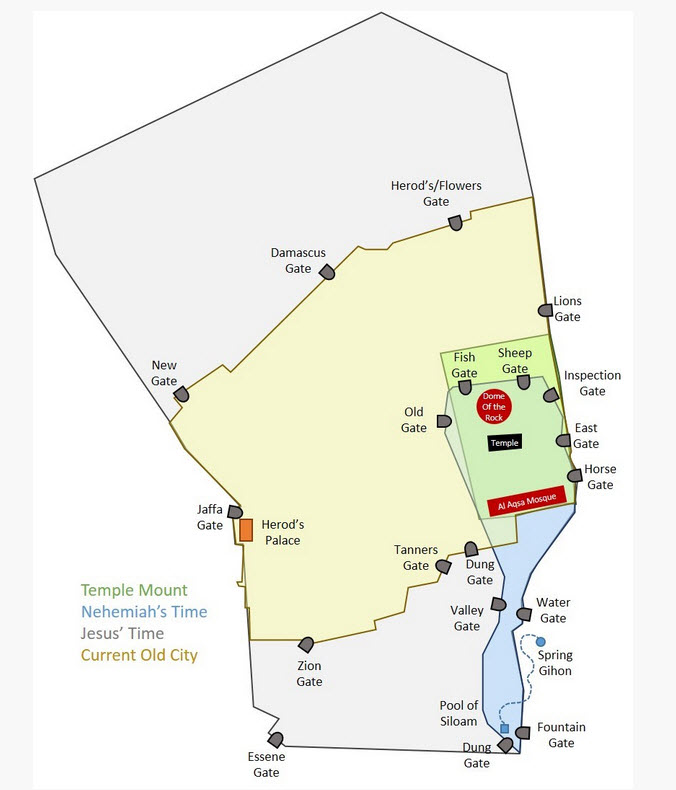 |
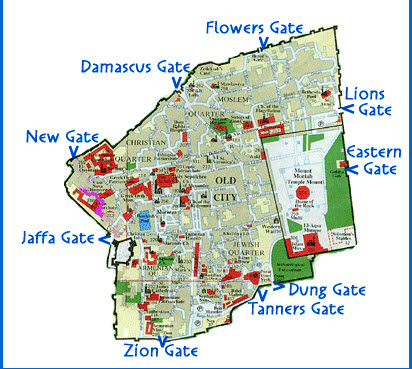 |
|
不同时代耶路撒冷的城门 |
现在的耶路撒冷旧城的九个城门 |
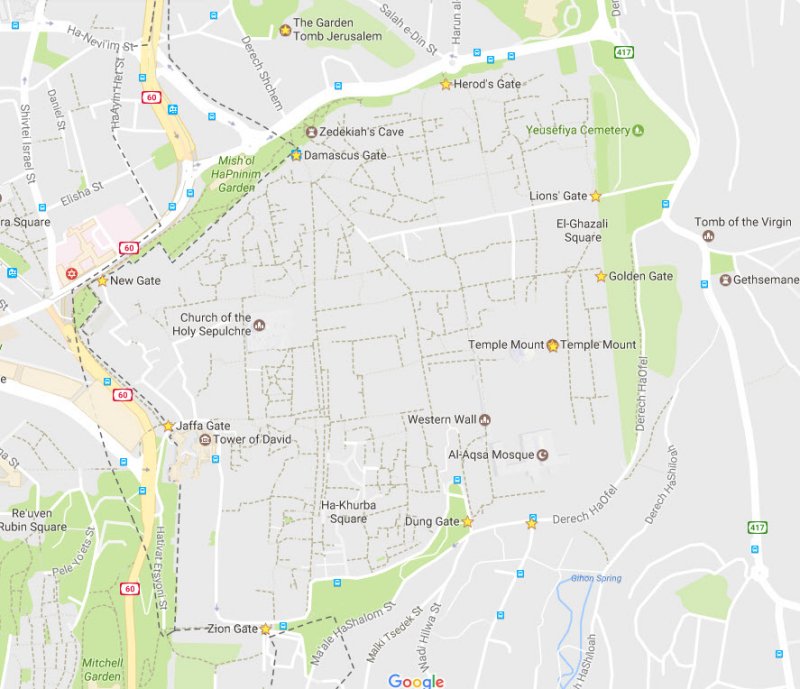
现在的耶路撒冷旧城的九个城门(Google Map)
|
现在的耶路撒冷旧城的九个城门 |
|
| Ref:http://www.itsgila.com/tipsgates.htm | |
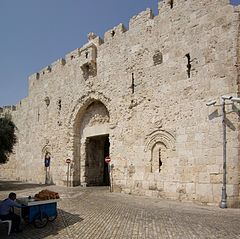 Zion Gate Zion Gate, on the southwest perimeter of the Old City,
leads from the tomb of King David and the Upper Room on Mount Zion into
the Armenian and the Jewish Quarters of the Old City. In Hebrew it’s
called Sha’ar Tziyon (Zion Gate) and in Arabic, Bab a-Nabi Daud (Gate of
the Prophet David). |
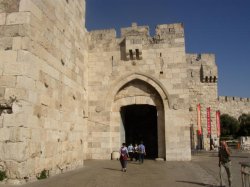 Jaffa Gate
Jaffa Gate, one of the city’s busiest, is located on the western
perimeter, right above Hinnom Valley, the Valley of Hell (Gehenna in
Greek). In ancient days, if you were a pilgrim who docked at the
Mediterranean port of Jaffa and walked east for three days, or perhaps
more, along the Jaffa Road, you would eventually reach the Jaffa Gate.
Hence its name. In Hebrew the gate is translated Sha’ar Yafo. Yafo is the
name for Jaffa in the Hebrew Bible, mentioned for example, in the Book of
Jonah. |
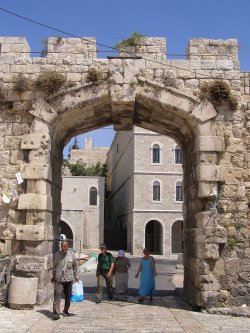 New Gate New Gate is located on the northwestern perimeter of the walled city. Its Hebrew name is Sha’ar Hadash and its Arabic name is Bab el Jedid, both meaning “new.” The gate was opened in 1887 by the Turkish sultan Abed el Hamid after intense lobbying by Christians who had settled outside the walled city and wanted direct access to the Christian Quarter and the Church of the Holy Sepulcher. |
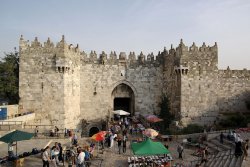 Damascus Gate
Damascus Gate, on Fridays and Saturdays, is the busiest gate leading into
the city, with hundreds and sometimes thousands of shoppers looking for
bargains, home-grown spices or the freshest fruits. Located along the
northern wall of the Old City, Damascus Gate is named after the most
important city to the north during nearly every historical period. Its
Hebrew name is Sha’ar Shechem, meaning Nablus Gate, after the northern
city of Nablus, established by the Romans 1900 years ago. |
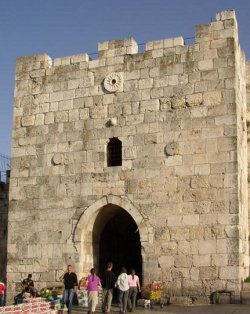 Flowers Gate (Herod's Gate)
Herod’s Gate, also called Flowers Gate, is located on the northeastern
perimeter of the Old City. |
 Lions Gate
Lions Gate, located on the eastern perimeter of the Old City, is also
known as |
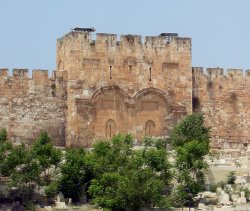 Golden Gate (Eastern Gate) The Eastern Gate was identified by the
Prophet Ezekiel when he wrote in chapter 44, “The prince will enter
through this gate and he will eat bread before the Lord.” This is the
origin of the Judeo-Christian belief that the Messiah will enter through
the eastern gate. |
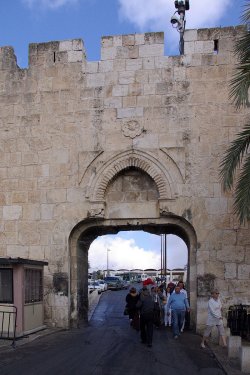 Dung Gate Dung Gate. From inside the city, to reach the gate, one would walk downhill and it’s where Old City residents, over the centuries, would throw their garbage. Can you imagine anyone ever walking uphill to throw their garbage? Well, that name stuck in Hebrew as well – it’s called Sha’ar Ashpot. Paradoxically, the Dung Gate is today one of the cleanest areas in the Old City. In Arabic the gate is called Bab el Mugrabi meaning the gate of the North Africans. During the Turkish times there was a neighborhood inside the Dung Gate, close to the Wailing Wall called the Mugrabi neighborhood whose residents had originated from North Africa. When you enter the Old City through the Dung Gate, you’ll
walk up directly through the security outpost to the Western (“Wailing”)
Wall plaza. If it happens to be a weekday when the Temple Mount is open to
Jews and Christians, you can view the Dome of the Rock and the El Aqsa
Mosque from close-up and photograph the inside |
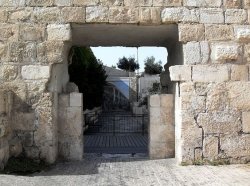 Tanners Gate Tanners' Gate is located in the Old City's southern wall, near the Dung Gate. It is the second oldest entrance into the Old City, a pedestrian gate probably built in the 12th Century by the Crusaders near a cattle market (hence the name). Suleiman the Magnificant filled in Tanners' Gate when he built the present-day Old City walls, gates and towers. The gate was discovered during post-1967 archeological investigations, partially reconstructed and interpreted as part of the Beth Shalom Garden. It was studied further during excavations along the Old City walls in 1995. The Jerusalem Foundation supported archeological excavation and restoration of the gate and construction of an adjoining plaza into the Old City, which was dedicated to the memory of Yitzhak Rabin in 1996. The restored gate was the first new opening into the Old City walls since 1887. |
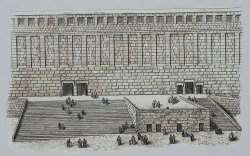 Huldah Gate (两组封闭的城门:左边两个和右边三个)
右边的三个城门 The Huldah Gate is sealed and situated on the southern wall area.
Named for the prophetess in 2 |
“哈西拿的子孙建立鱼门(fish gate),架横梁、安门扇和闩锁。”(But the fish gate did the sons of Hassenaah build, who also laid the beams
thereof, and set up the doors thereof, the locks thereof, and the bars
thereof.)(尼三:3)
“管理米斯巴、各荷西的儿子沙仑修造泉门(the gate of the fountain),立门、盖门顶、安门扇和闩锁。。”(But the gate of the fountain repaired Shallun the son of Col-hozeh, the ruler of part of Mizpah; he built it, and covered it, and set up the doors thereof, the locks thereof, and the bars thereof。。)(尼三:15)
修造或建立城门的时候,我们就看到有架横梁(laid the beams)、立门(built)、盖门顶(covered)、安门扇(set up the doors)和闩锁(locks and the bars)。。这方面的资料相当缺乏,我们会掠过不谈。下图是耶路撒冷的一个古城门,现已封闭不用。
从下一课开始,我就和大家进入正文,一同查考《尼希米记》。有问题要提出来讨论吗?欢迎您和我联络。电邮地址是:
![]()